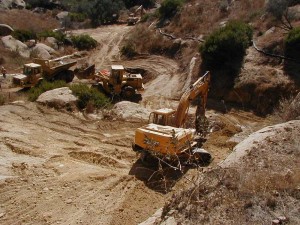 PART TWO – DIRTY DEEDS
PART TWO – DIRTY DEEDS
With no real cleanup deal Boeing bulldozes the gooey evidence right under the public’s nose
Boeing’s bold plan to greenwash the polluted Santa Susana Field Laboratory (SSFL), more infamously known as Rocketdyne, isn’t surprising taking into account the corporate behavior of Boeing and preceding SSFL owners.
That behavior indicates an “anything goes” mentality that existed for decades, much to the detriment of its workers according to several health studies, as well as impacting the communities around Rocketdyne and possibly the Los Angeles River as public access increases.
Boeing’s cavalier approach carries on today as evidenced by its complex and costly campaign to avoid cleaning up the contaminated site to background. The only difference is unlike discovering pollution problems from decades ago and reporting their significance, this stratagem is ongoing and developing according to the Make Over Earth draft media campaign. The plan to paint Rocketdyne clean and green just doesn’t gel with the history of Rocketdyne.
In testimony before the US Senate in 2008, Dan Hirsch, president of the nuclear watchdog organization Committee to Bridge the Gap, told quite a different story about the Santa Susana Field Laboratory.
In the late 1940s, the Atomic Energy Commission commenced a search for a remote site in Southern California for nuclear work too dangerous to perform near populated areas. In the decades since SSFL was established, the Southern California population mushroomed, so that now more than half a million people live within ten miles of the site. Over the years, SSFL was home to ten nuclear reactors, a plutonium fuel fabrication facility, and a “hot lab” for cutting up irradiated nuclear fuel shipped in from around the country, plus over 20,000 rocket tests, as well as munitions development and “Star Wars” laser work. Sloppy controls, an indifference to environmental rules, and a history of spills and accidents have created a legacy of radioactive and chemical contamination. A history of broken cleanup promises has left the vast majority of that contamination still in place.
Indeed, several accidents involving nuclear reactors have released radioactive gases into the atmosphere. In 1959, a fuel rod exploded at the lab while being washed with water, flooding the reactor with radioactivity that was vented outside. In 1960, a reactor pipe being moved outdoors for decontamination exploded and sailed across a ravine. In 1997, Rocketdyne settled out of court with Brandeis-Bardin Institute, in eastern Simi Valley, over charges the company had polluted the institute’s groundwater and devalued its property. Two Rocketdyne physicists were killed in 1994 when the chemicals they were incinerating exploded. Following a federal grand jury investigation, Rocketdyne’s former parent company Rockwell International pleaded guilty to felony counts of improper storage and disposal of hazardous materials and was fined $6.5 million.
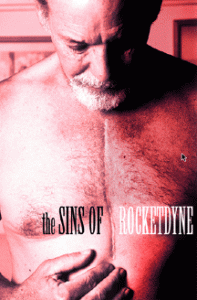 Workers like Jim Economopoulos, featured in the Los Angeles CityBeat/ValleyBeat cover story “The Sins of Rocketdyne“, were regularily exposed to toxins. Working at SSFL from 1975 to 1978, Economopoulos was splashed with trichloroethylene (TCE) on his pants up to his knees. He lost 40 pounds from sickness, his pancreas blew up and he became a Type 1 diabetic. Later, he contracted bone cancer which he said was a result of working at Rocketdyne.
Workers like Jim Economopoulos, featured in the Los Angeles CityBeat/ValleyBeat cover story “The Sins of Rocketdyne“, were regularily exposed to toxins. Working at SSFL from 1975 to 1978, Economopoulos was splashed with trichloroethylene (TCE) on his pants up to his knees. He lost 40 pounds from sickness, his pancreas blew up and he became a Type 1 diabetic. Later, he contracted bone cancer which he said was a result of working at Rocketdyne.
“I thought I was doing something for the country, but I didn’t know I was killing myself. If I had known that…,” Economopoulos said, and then broke off in a painful silence.
It is hard to believe that individuals like Economopoulos took it upon themselves to operate unsafely and deliberately vent gaseous goo into the atmosphere on their own volition. Owners of the Santa Susana Field Laboratory past and present have had a long litany accidents and deliberate releases that indicate a corporate cowboy culture where anything goes.
Mitt Romney famously said “Corporations are people, my friend.” In Boeing’s case, it is a person that will live a very long time and it can afford to use that time wisely. The company seems so sure of itself that it is beginning to congratulate itself over the SSFL cleanup even as new and shockingly high readings of contamination are made public. Boeing has bet that the public has forgotten about Rocketdyne and that it’s time to come in for the peachy-keen kill.
DINNER THEATRE
Boeing’s creative spark to repaint the Santa Susana Field Laboratory broke new ground September 20 at the Rococo Room in Old Town Pasadena during a dinner and presentation held by an industry group called the Los Angeles Basin Section of the California Water Environment Association.
The presentation, “Sharing An Open Space Vision – The Boeing Experience in Clean-Up and Environmental Services,” was given by Paul Costa, senior manager for Environmental Protection for SSFL. Costa also sits on the board of directors for Friends of Ballona Wetlands. The colorful invitation to the $40 dinner applauded Boeing’s work on cleanup of the lab.
“While the technical challenges of this site were being assessed, public concerns regarding site contamination lead to cleanup that is vastly more stringent than well-established state and federal law,’ the invite read, leaving out that Boeing fought the state Department of Toxic Substances Control – and won – in court over having to clean up to these higher standards. “This presentation provides a case study on how Boeing integrated the technical challenges of cleanup with community concerns to demonstrate to local stakeholders that Santa Susana could be – and would be – a public benefit if comprehensively and responsibly remediated using standards that are both protective and responsible in returning the area back to open space parkland.”
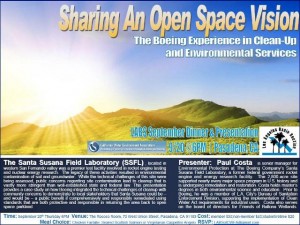 Seated in the audience that night was somebody to whom LABS may wish they hadn’t sold a ticket. William Preston Bowling is a Rocketdyne cleanup activist who knows the site as well or better than anyone. Bowling’s Aerospace Contamination Museum of Education, or ACME-LA, has been a major Rocketdyne cleanup resource since it first began September 13, 2006. ACME-LA had a bricks and mortar museum from 2008 to 2009 which was then called the Aerospace Cancer Museum of Education.
Seated in the audience that night was somebody to whom LABS may wish they hadn’t sold a ticket. William Preston Bowling is a Rocketdyne cleanup activist who knows the site as well or better than anyone. Bowling’s Aerospace Contamination Museum of Education, or ACME-LA, has been a major Rocketdyne cleanup resource since it first began September 13, 2006. ACME-LA had a bricks and mortar museum from 2008 to 2009 which was then called the Aerospace Cancer Museum of Education.
Bowling nearly dropped his fork as Costa embarked on a voyage of Boeing self-congratulation, but not because of the undeserved self-awarded green bona fides that he already expected. It was because of what Costa said about the future use of youths at risk from the LA Conservation Corp (LACC) doing Rocketdyne’s dirty work creating in the field Best Management Practices systems usually involving the making and placing of hay bales. BMPs in this case would involve using these hay bales to funnel SSFL runoff.
These BMPs would help retard the flow of goo in an attempt to keep it on the lab proper instead of what it has doing for years, flowing down into the Brandeis-Bardin campus of American Jewish University which is north of Rocketdyne in Simi Valley. Brandeis’Bardin sued then-lab owner Rockwell in the late 1990s over the pollution, which resulted in a confidential settlement said to be quite robust. That settlement included Boeing, lab owner since 1996, buying tritium-tainted land from the campus and renaming it the Northern Buffer Zone.
“We hired the LA Conservation Corps to put BMPs in the Northern Drainage,” Costa told the crowd of around forty people according to Bowling who was accompanied by an official from Friends of the Los Angeles River, FoLAR. “We just sent them the check!”
Bowling knows all about the Northern Drainage. In 2007, with then-partners Christina Walsh and John Luker, Bowling discovered a huge amount of toxic debris from NASA’s LOX plant on the northern edge of the property that utilized liquid oxygen and, in the process, created tons of waste. EnviroReporter.com and the Ventura County Reporter both covered the remarkable cleanup:
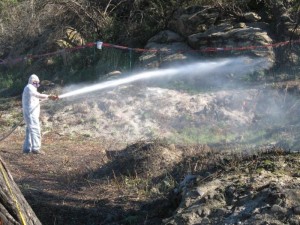 “The Boeing workers in the otherworldly suits looked out of place trudging through the dry creek bed that separates Sage Ranch Park and the Santa Susana Field Laboratory Nov. 20. Outfitted in head-to-toe translucent plastic uniforms with air filter masks, goggles and gloves, they chain-sawed a swath through the brush and trees blocking the seasonal stream. As they worked, their quarry appeared: black and grey blocks of lung-destroying asbestos and broken pipes with the toxic heavy metal antimony. All the while, a worker used a high pressure hose to spray down the area to keep the lung-destroying asbestos from becoming airborne.”
“The Boeing workers in the otherworldly suits looked out of place trudging through the dry creek bed that separates Sage Ranch Park and the Santa Susana Field Laboratory Nov. 20. Outfitted in head-to-toe translucent plastic uniforms with air filter masks, goggles and gloves, they chain-sawed a swath through the brush and trees blocking the seasonal stream. As they worked, their quarry appeared: black and grey blocks of lung-destroying asbestos and broken pipes with the toxic heavy metal antimony. All the while, a worker used a high pressure hose to spray down the area to keep the lung-destroying asbestos from becoming airborne.”
Expensive professionals come equipped to protect themselves from the types of toxins that have contaminated Rocketdyne. The less costly LA Conservation Corps workers do not have a history of donning haz-mat outfits when working sites like SSFL.
Usually unskilled but eager to learn, the LACC’s teams of at-risk young adults and school-aged youth built or maintained an astonishing 393,373 linear feet of trails from 2009 to 2010 according to the non-profit’s annual report for the period. With 993 young employees, LACC also managed to plant and maintain 2,521 trees and 204,332 square feet of gardens, remove 75,418 square feet of graffiti and collect and dispose of 1,543,395 pounds of litter and debris.
Using potentially unawares youth to work the land that previous skilled workers in hazmat suits had toiled in to remove the goo made Bowling livid. He was shocked hearing Costa announce this at the dinner especially with such pride.
“This is very disturbing, how they are taking these kids to install BMPs in the Northern Drainage of the field lab, the same drainage where they had to remove 3 football fields of contaminated soil and they still keep finding stuff, like 1100, yes Eleven Hundred Class C explosives buried under some trees,” Bowling said in an e-mail September 24. “This area was a dumping ground and they planted on top of it, hence the findings under trees. What Boeing is doing is getting around paying experts to do this work and having the LACC do it for minimum wage all the while the LACC does not know the dangers of working up there.”
Perhaps it’s a case of Boeing drinking its own PR Kool-Aid believing that it’s A-OK to have these kids on the site instead of professional remediation experts. After all “The site poses no significant risk to human health today” according to the Make Over Earth plan.
AN AWARD ONLY A POLLUTER COULD LOVE
 A November 16, 2012 press release from Boeing’s SSFL offices furthered the notion that the grossly polluted lab is one step shy of a gooey Garden of Eden.
A November 16, 2012 press release from Boeing’s SSFL offices furthered the notion that the grossly polluted lab is one step shy of a gooey Garden of Eden.
“Boeing Receives Environmental Recognition from Wildlife Habitat Council – Educational programs certified at Santa Susana Field Laboratory” read the release which blithely said that a “transformation is underway at the 2,850-acre site as it evolves from a legacy of testing and research toward a future as open space benefitting the community.”
Longtime members of the communities surrounding SSFL might take issue with this glowing take on Rocketdyne. Boeing has spent tens of millions on settlements with people who said the site has made them ill over the years, studies show elevated cancers near the site, and recent EPA studies revealed contamination thousands of times over background remains at SSFL.
Judging the recent press release, however, the suffering of workers and public health concerns aren’t the legacy that it is thinking of according to its site director, Boeing’s Tom Gallacher. “Most people are aware of the site’s significant role in the historical research of rocket engine propulsion development and energy research,” said Gallacher in the press release. “What surprises most people is that this site is a key habitat for a variety of native plants, flowers and wildlife.”
The award that Boeing received from the Wildlife Habitat Council (WHC) came from a group dominated by massive international companies infamous for their environmental degradation and disasters even as the group claims it “devotes its resources to building partnerships with corporations and conservation groups to create solutions that balance the demands of economic growth with the requirements of a healthy, biodiverse and sustainable environment.”
Current WHC board members include chemical giant DuPont, multi-national oil and energy company ExxonMobil Corporation and multinational agricultural biotechnology corporation Monsanto. Monsanto was the source of 99% of the polychlorinated biphenyls (PCBs) used by U.S. industry until 1977 when the company was forced to stop production on the toxic and persistent organic pollutant which still flows off of SSFL down into the Los Angeles River.
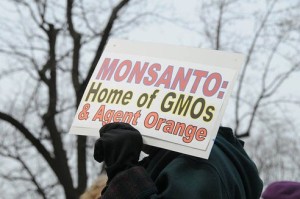
But perhaps Boeing does deserve an award for its greenwashing efforts. The company has done a fine job of exploiting lovers of birds and bees in an attempt to evade cleaning up SSFL. In a June 2012 Los Angeles Daily News article entitled Environmental groups weigh in on Santa Susana Field Lab’s future,” features Mark Osokow, a board member of the San Fernando Valley Audubon Society who has been vocal in backing Boeing’s open space initiative.
The article quotes Osokow, “‘The environment here is very good for the birds,’ said Osokow, who has a deal with Boeing to study birds on the property. ‘It’s about as pristine as you can get.'”
Osokow didn’t mention that polluted Rocketdyne water awaits birds and wildlife in that “pristine” environment. The Silvernale reservoir is polluted by hydrazine, DCE, trichloroethylene, methylene chloride and trichlorotrifluoroethane.
Plus, it smells like a “cesspool” according to Lewis MacAdams, co-founder of FoLAR, who visited the site with Bowling in February 2012. Certainly not the avian nirvana that Boeing is trying to fly by birders and the public.
Also in June Boeing debued it’s first ever “Bee Fest” in celebration of National Pollinator Week. The event included information about pollinators, guided biological walks and activities for children like “Pin the Stinger on the Bee”, according to Boeing’s November newsletter which looks more like a Sierra Club newsletter than that of an aerospace corporation faced with cleaning up an astronomically polluted site.
DUST DEVILS
Dubious awards from polluters gifted to their aggressive and powerful colleagues are just one challenge in shaping public discourse faced by people like Bowling. The Malibu and Topanga-area real estate agent doesn’t seem fazed by the might of Boeing and its award-giving industry allies.
 “Wild Bill” Bowling is also a Radiation Ranger who has been fighting development at adjacent Runkle Canyon where Westwood-based KB Homes plans to build 461 homes and condos. [KB Home’s Runkle Canyon development is now called Arroyo Vista at the Woodlands.] He has been at the forefront of citizen activism over cleaning up Rocketdyne since first reading this reporter’s coverage of SSFL at the turn of the millennium.
“Wild Bill” Bowling is also a Radiation Ranger who has been fighting development at adjacent Runkle Canyon where Westwood-based KB Homes plans to build 461 homes and condos. [KB Home’s Runkle Canyon development is now called Arroyo Vista at the Woodlands.] He has been at the forefront of citizen activism over cleaning up Rocketdyne since first reading this reporter’s coverage of SSFL at the turn of the millennium.
Bowling opened the Aerospace Cancer Museum of Education in Chatsworth Lake Manor downhill from Rocketdyne in May 2008. “I started ACME with an application for fiscal sponsorship in my name only as was told to do so by Lauren Bon, chair of the Annenberg Foundation,” Bowling told EnviroReporter.com. “She told me, ‘I can give you money, but you need an umbrella [non-profit organization to accept donations for [ACME-LA] first.’ Then I found the building and signed a lease and paid for first, last and deposit with my own money, even before the grant was gifted.”
Part of the grant money was used to set up a time-lapse photography camera in a blind on Sage Ranch Park hard on Rocketdyne’s northeastern border near the guarded entrance to the property in June 2009. From a vantage point on a hill across from Area I, the hidden-in-plain-sight camera filmed the videos which are embedded below. The films capture Boeing’s haphazard demolition techniques.
One video shows heavy machinery in Area I of the lab roaring around destroying and grading the last of what once was the Instrument and Equipment Laboratories or IEL complex. Huge clouds of dust are launched into the air landing on any SSFL subcontractors and full-time lab workers that may have been in the area as well as drifting towards the San Fernando Valley. Most of the contaminated dust falls out on hills that drain down Happy Valley above Chatsworth into Dayton Canyon Creek and finally the Los Angeles River.
The IEL and the land around it are contaminated from decades of use of the toxins trichloroethylene, perchlorate, trichloroethane, hydrazine, perchloroethylene, hexavalent chromium, and heavy metals. This dangerous dirt appears to have been blown all over the place by Boeing’s plainly sloppy procedures.
The clouds of dust are particularly disconcerting when considering that the area had a leach field where unknown amounts of goo were poured for years with no records. The films do not show if the workers were wearing masks but it’s clear no effort was made to keep the giant billows of toxic filth from flying up in the air with water truck sprayers to keep the dust down.
The recording to the right shows the distant demolition of an extremely contaminated area of Area I with seemingly no regard for the huge clouds of toxic dust that the heavy construction equipment was creating.
Beginning at 9am June 4, 2009, according to the video time stamp, a rising cloud of dust from demolition is seen until about 11:15am. Then there’s a break, maybe for lunch, and subsequently the billowing dust starts back up again at 12:15pm and lasts until about 4:30pm.
Farther along on the tape on June 6, a great wind starts up at noon blowing all sorts of dust around from the now graded site. On June 7, intermittent blasts of dust from tractors begin at 10:40am and continue to about 3pm. The dust clouds start up at about 8am on June 8 and continue to 3:30pm at the end of the tape. The tape’s June 8 wafts of dust recorded the highest and densest plumes traveling off-screen and down into Woolsey Canyon at the northwest end of the San Fernando Valley.
“From what I can see is they have already torn down building 408,” Bowling wrote in a May 16, 2012 e-mail to EnviroReporter.com. “Look at about 5:38-5:40, there is a red crane tearing down buildings 1303, the igniter packing building and 1396, explosives storage – Perchlorate!”
Building 1303 was used as a propellant laboratory using perchlorate and other energetic compounds. A February 2009 Boeing environmental assessment report required by DTSC said of 1303 “This laboratory was indicated as discharging to a former industrial dry well located in a topographic low near current Building 1436.” In other words, the dregs of perchlorate tests were dumped in a hole dug into the ground in a ditch outside. This is the area that Bowling caught on film being bulldozed in clouds of dust.
The mini cyclones of contaminated crud Boeing made aloft on film comes from one of the most polluted places on the entire SSFL property – Area I. The film captures the final demolition and grading of a cluster of some of these poisoned places where buildings had been knocked flat and presumably hauled off to a dump.
Building 1301 just north of 1303, the Equipment Laboratory TCA Distillation Unit and Used Product Tank, was constructed in the late 1940s and used as a machine shop and then utilized for servicing, cleaning, and testing engine valves and manifolds. Chemicals used for valve repair included nitric acid, phosphoric acid, and hydrofluoric acid along with the carcinogenic solvents TCE and TCA. “In 1987, approximately 175 to 200 gallons of TCA were released accidentally from the solvent distillation unit on the northwest side of the building and flowed across the Area I Road, and into an adjacent asphalt-lined drainage ditch where it was contained by use of vermiculite,” according to a 1987 Rockwell report.
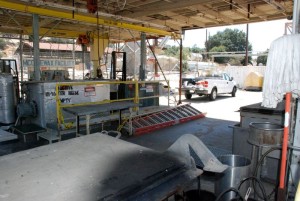 A 1994 report noted that “South of Building 1301, the Acid Bay was used for parts cleaning and included several above-grade cleaning tanks, a below-grade solvent pit, and waste ASTs [aboveground storage tanks].” The same survey found that toxic TCA was spilled from solvent ASTs and forced Rocketdyne to dig up 400 cubic yards of impacted soil and asphalt road base.
A 1994 report noted that “South of Building 1301, the Acid Bay was used for parts cleaning and included several above-grade cleaning tanks, a below-grade solvent pit, and waste ASTs [aboveground storage tanks].” The same survey found that toxic TCA was spilled from solvent ASTs and forced Rocketdyne to dig up 400 cubic yards of impacted soil and asphalt road base.
Twenty-seven oil/PCB chemical use areas were identified at the Instrument and Equipment Laboratories in four general areas near the Building 1301 structure cluster. Eleven metals and inorganic compounds chemical use areas were also identified in the vicinity. That would include “cleaning operations inside Building 1301, where dip tanks were used, and at the Acid Bay Area located south of Building 1301,” noted the 1994 report.
The amount of TCE and TCA found in the soil, that same soil Bowling captured blowing all over the place was staggering: 1,1-TCA up to 2,000 μg/kg in soil and 4,800 μg/Lv in soil vapor and TCE up to 11,200 μg/kg in soil and 2,800 μg/Lv in soil vapor.
Bowling blames Boeing’s demolition procedures as seen on the films on the company’s refusal to abide by the Agreements on Consent (AOCs) which require NASA and the DOE to clean up their parts of the lab to background levels. Boeing wants to bulldoze and be done with it, Bowling says. After all, that does fall in line the Boeing Makeover Earth plan to declare the place already safe and ready for primetime as parkland.
Bowling contrasts Wind with the other video embedded to the left, in which is seen a very carefully done cleanup of Outfall 8 which was ordered by the Los Angeles Regional Water Quality Control Board (LARWQCB) because of continuing Boeing exceedances of goo flowing off its property. It involved excavating polluted dirt from the outfall and packaging it up burrito-style and loading into trucks which were carefully cleaned of any toxic dirt on their wheels and undercarriages before leaving SSFL to haul their sullied loads to a licensed dump.
“Here is what is going on,” Bowling says explaining the two films. “Careful and lovely work in the foreground is the Outfall 8 cleanup from the RWQCB. The other outrageous crap in the background is the stuff that makes my blood boil. I have complained that there has been no oversight or public comment periods or even that DTSC is looking the other way, but since Boeing challenged SB 990 [a state law ordering strict cleanup standards], they have been tearing down everything to a standard that who knows what.”
TOXIC TOLL
Debating levels of chemicals and radionuclides at Rocketdyne can make the issue of cleanup of the lab confusing. While the majority of the community understands and supports the AOCs that dictate remediating the land to background levels of radiation and chemicals, Boeing’s media campaign and sloppy demolition procedures literally bulldoze the point home that the company thinks otherwise.
Past studies of the health effects of SSFL goo on the lab’s workers and the surrounding communities suggest that ignoring what Boeing would leave in place might suggest serious safety issues for future users of the land as well as those downstream along what becomes the Los Angeles River.
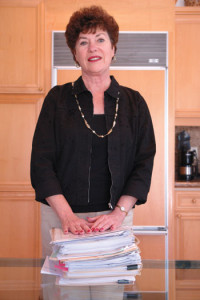
The September 1997 study results weren’t good for the workers of Area IV where nuclear reactors, a hot lab and a radioactive sodium burn pit was used to incinerate hot goo. “All available evidence from this study indicates that occupational exposure to ionizing radiation among nuclear workers at Rocketdyne/AI has increased the risk of dying from cancers,” wrote Dr. Hal Morganstern, director of the UCLA study. “We found the effect of radiation exposure was six to eight times greater in our study than extrapolated from the results of the A-bomb survivors study.”
The other gooey shoe dropped two years later with a January 1999 UCLA’s School of Public Health of long-term study of Rocketdyne employees exposed to a soup of toxic chemicals while working on the company’s giant rocket test-stands. The results were again grim: Increased rates of cancer were found, especially among workers who handled hydrazine, a high-octane gel used as a rocket-engine propellant. Two million pounds of hydrazine were used at Rocketdyne during the ’50s and ’60s.
UCLA found that Rocketdyne workers who had high hydrazine exposures were about twice as likely as other Rocketdyne employees who worked at the site to die from lung and other cancers. The study shows that 44 in 1,053 workers who had frequent contact with the compound, had died from lung cancer. That rate was twice as high as for the employees who had minor or no contact with the chemical, which has been found to be carcinogenic in lab animals and a “possible carcinogen” to humans.
Excessive deaths from cancers of the kidney, bladder, blood and lymphatic system were also observed, although the lung-cancer numbers were the most startling. “While we believe that something is going on with this group of workers, we don’t know for certain what caused the excessive cancer deaths,” said Beate Ritz, a UCLA epidemiologist and co-investigator on the study, in LA Weekly. “Our best information is that it was hydrazine, but it could be something else related to rocket-engine testing. We do know there is an excessive number of cancer deaths among workers in the high-exposure category.”
A five-year study commissioned by the state legislature announced its results in October 2006 detailing the probable cancers caused by the partial meltdown of just one of the experimental reactors that had serious accidents in Area IV, the Sodium Reactor Experiment. The 1959 meltdown likely caused cancer in 260 to 1,800 people within a 62-mile radius of the eastern Ventura County lab hard on the border with Los Angeles County. The $200,000 report released figures for escaping radionuclides that show that the disaster released 459 times more of the deadly radionuclides iodine-131 and cesium-137 than Pennsylvania’s Three Mile Island meltdown did in 1979, according to a Los Angeles CityBeat article.
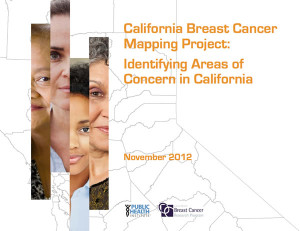 News of offsite illnesses appears to be worse with the release of the November 2012 Public Health Institute’s California Breast Cancer Mapping Project (7.95 MB) which showed that women in east Ventura County have the highest rate of breast cancer than almost all other areas of California. Western Los Angeles County and Simi Valley are one of four California regions that have a 10 to 20 percent higher invasive breast cancer rate than the rest of the state.
News of offsite illnesses appears to be worse with the release of the November 2012 Public Health Institute’s California Breast Cancer Mapping Project (7.95 MB) which showed that women in east Ventura County have the highest rate of breast cancer than almost all other areas of California. Western Los Angeles County and Simi Valley are one of four California regions that have a 10 to 20 percent higher invasive breast cancer rate than the rest of the state.
Though the study makes no mention of SSFL as a possible cause, the rate of breast cancers in this region, with Rocketdyne right in the center of it, has been consistently higher than the rest of California for the last nine years. Non-Hispanic white women are affected the most with 73 percent of the cases. Hispanic women accounted for 12 percent of the total and 8 percent Asian females. The American Cancer Society says that ionizing radiation causes breast cancer.
These numbers are easier to understand than complicated calculations for contaminants that cause a world of hurt in only the way the Pandora’s Box of pollutants used at the lab can do. Cleaning up to background and trying to right the situation, and not a blizzard of Boeing baloney about why it shouldn’t have to, is also a fairly simple and straight-foward concept.
RELATED – Rocketdyne Video
The longtime residents fighting for cleanup, and the hundreds of community members who support them, know through their own battles with cancer what it means to live next to the Santa Susana Field Laboratory. For over two decades, they fought to clean the place up so it couldn’t harm future generations. They thought that the government and responsible parties had finally delivered them from this nightmare in 2010.
They were dead wrong.
Related Material: “A Trail of Flames” & “A Keen Observer“
NEXT PART THREE – OPERATION ASTROTURF
25 Years of Award-Winning SSFL/Rocketdyne Reporting
1998 – 2023













I played in these hills ALL my life, and lived not far from there, my family today has rashes, and leukemia. WTF? Why weren’t we informed about this disaster? We the people need a class action lawsuit.
There is a company (based in Nevada) that is still searching for former employees. This company helps them file lawsuits. Even as recently as five years ago, this company was watching and, out in Simi Valley.
I wish I could remember their name as they are probably a wealth of information.
Hopefully, one of your readers will know their name. And, wouldn’t it be helpful to be able to talk to former employees.
On a personal level, I would love to yell and scream at the employee who dumped toxic waste in a little stream where children played. I think this was in the area now called West Hills or near there. And, it was at a time when he knew darn well what he was dumping. We even heard about it over in Woodland Hills.
I still think about those young children, and what might of happened to them. It is close to impossible to find anyone from the neighborhood anymore who actually witnessed it.
All I remember hearing is that people watched and DID NOTHING!!!!!!!!!!! SHAME ON THEM!
William,
Thanks for that additional information. I will check your website. Wow. I would imagine the Center for Land Use Interpretation would have an interest in an exhibit on this?
Many thanks,
SBL
Hi SBLOCAL,
The Diversion Tunnel construction can be seen here, on a website I built…
http://www.chatsworthreservoir.com/1970s.html
It’s in use, and has been in use since late 1972, it’s a tunnel, yet, it’s intended purpose was “To improve the water quality of the Chatsworth Reservoir”
The water does go into the LA River and may reach the Tillman Reclamation Plant at Sepulveda Basin in certain Rain Events.
In the 1954 SRE Preliminary Safety Evaluation document, it includes a contingency plan if the reservoir would be tainted from the Sodium Reactor Activities…
http://www.acmela.org/images/Prelim_Safety_Evaluation_SRE_Feb_19_of_1954.PDF
In addition to the IEL Fault, the Burro Flats Fault, connects AREA IV of Santa Susana to the Chatsworth Reservoir.
William Preston Bowling
Founder ACME
Aerospace Contamination Museum of Education
@William Preston Bowling can you clarify what happened with the diversion tunnel? Do you mean that the diversion tunnel was never used because of the detected contamination in 1969?
So where, subsequent to that discovery, DID the contaminated water from the lab go if not into the LA River? Into the local sewage treatment plant?
This is incredible stuff. Thank you so much for sharing it.
The SAGA Continues,
Today, the Department of Toxic Substances Control released their monthly status report regarding activities related to the Santa Susana Field Laboratory and I noticed something, well, two somethings…
ONE, The Boeing Co. had Demolished more buildings in AREA IV, Violating the Administrative Orders on Consent (AOC) and the Judge Conti Order (City of LA, NRDC and CBG vs. The Boeing Co.) and have submitted plans to DTSC for the Demo of Buildings 4009, 4100 and 4055, yes, radiological buildings.
If that does not get your blood to boil…
TWO, The video in this article (Above) that shows the Santa Susana Dustbowl is none other than the Instrument and Equipment Lab (IEL) in AREA I, as we are told, a non-radiological area, yet after the fact, or after demolition, according to the DTSC Monthly Status Report, Jan 2013, confirmation sampling found Uranium that exceeds the Radiological Trigger Levels, one more tidbit, the EIL has a geological fault named after it, THE IEL FAULT, that heads down Woolsey Canyon into the Chatsworth Reservoir, any thoughts why it’s is still dry after 40 years, DWP, who owns the Reservoir will tell you it was because of the 1972 Earthquake, yet it was drained in 1969 to build a 12 million dollar (1969 Money) diversion tunnel to divert runoff from the lab to a tunnel under the Hidden Lake community into the Los Angeles River. But the joke was on them, cause, after the tunnel was built, contaminated groundwater was found seeping into the main areas beyond the tunnel, so, as they say… “So much for that”
We need a proper cleanup to BACKGROUND for the Entire Site.
William Preston Bowling
Founder ACME
Aerospace Contamination Museum of Education
@Joan; Who EXACTLY are these guys? Scumbags pure and simple. Unless they get a spiritual awakening, don’t hold your breath for change.
The revelation of Boeing’s PR plan is absolutely stunning in its diabolical implications. That a former LA Times environmental reporter was so damaged by the sudden fall of the titan he used to write for that he has chosen to engineer a (highly paid) campaign that will lead innocent people into harm’s way and induce parents to expose their vulnerable children to terrible toxins is incredible.
The levels of corruption and greed and indifference to human suffering by the individuals making these decisions fits squarely in the psychotic category of personality disorders.
Or do they just hate us? Thank goodness for Michael Collins who refuses to allow these beasts to operate under the cover of anonymous darkness. An enemy of the state could do no more harm if they were to secretly leak chemical weapons in our midst.
Which begs the question: who exactly are these guys?
Being unwilling to clean up the Santa Susana Field Lab is one thing, but using school kids to do their dirty work is not only the ABSOLUTE WORST OF THE WORST….but gives new meaning to the concept of kids being “at risk”. Boeing not only deserves public censure for not providing protective outfits for these young workers, but they also deserve some effective legal prosecution,hopefully leading to an incredibly huge fine and/or some significant and lesson learning jail time!
Boeing has learned from Karl Rove and the current political environment: don’t DO a clean-up, just SAY you’ve done one to “vastly higher standards” than the public deserves.
Then foist the toxic site on the public. When future citizens start getting cancer from this open space that Boeing’s so kindly provided — who will pick up the tab? I’m going to go out on a limb here and forecast that Boeing will NEVER pick up the tab for the SSFL site.